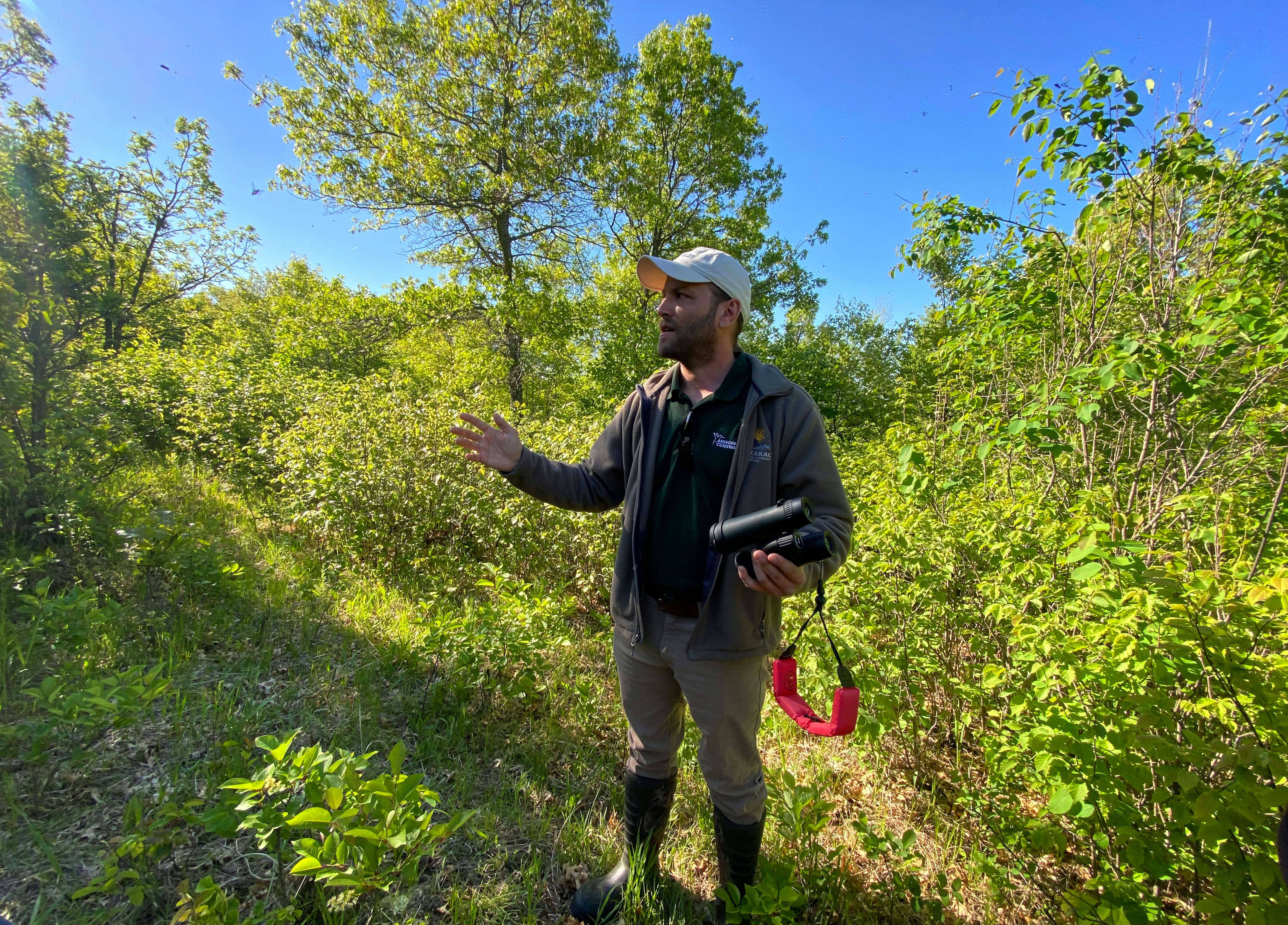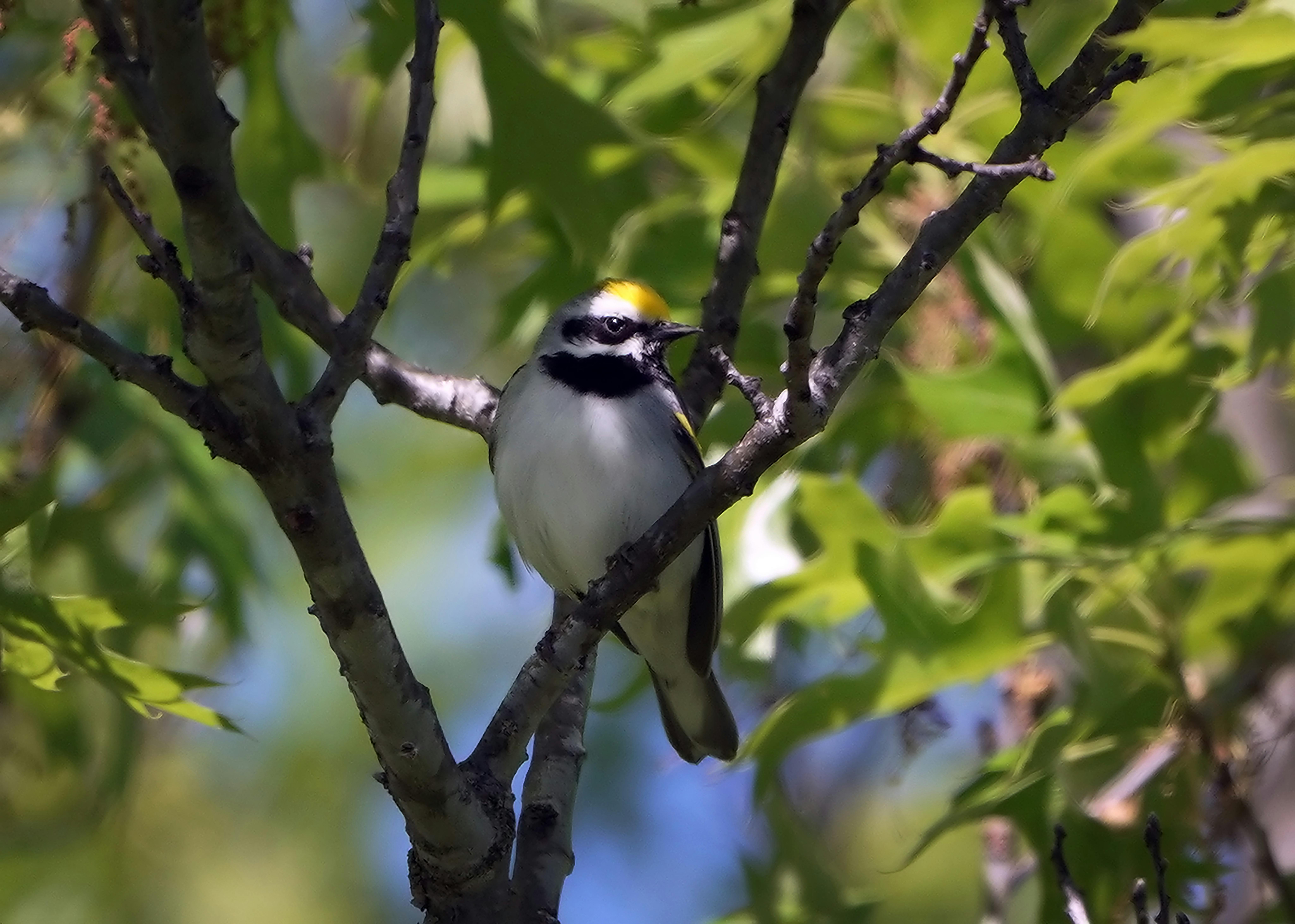The bird heard the call — a three-note whistle of another male in his territory — and got ready to fight.
Vanishing North
An occasional series in the Star Tribune documenting the biodiversity crisis and the people struggling to head off extinction for Minnesota’s most vulnerable animals and plants.
He darted among the oak trees, circling the sound, landing only briefly on the tips of the branches as he tried in vain to find his rival.
It was early June. The golden-winged warbler had just flown some 3,500 miles, from a tropical forest in Central America to the woods of northern Minnesota. But there was no time to rest.
Light through the trees haloed around the gold stripe of his head. The songbird weighed a third of an ounce — about the same as two sheets of loose-leaf paper. Yet he boldly sang out in defense of his territory, his nest likely hidden on the ground among hazelnut shrubs and grasses.
On this day, the calling invader was actually a recording played by one of the researchers watching the warbler. It's a distinctive and clear call, gentle to the human ear. But to another golden-winged warbler, it's a threat. The male stuck out his breast and whistled his own three-note tune, heedless of all the hawks and owls, all the raccoons and creeping predators, all the researchers standing there not bothering to hide.
Nesting space in Minnesota's Tamarac National Wildlife Refuge is something beyond precious for golden-winged warblers. The state's forests are one of the few significant breeding grounds left for the species.
Half of the golden-winged warblers left on the planet now breed in Minnesota. For the past several years, their numbers in the state have remained stable, even as they've fallen elsewhere. Now the question is whether foresters and conservationists can manage trees and brushlands in a way that will allow the birds' population to grow.
The future of the species depends on whether the birds can find mates, successfully nest and get their young ready to survive the grueling monthlong trek down the Mississippi Flyway to the shores of Texas, over the Gulf of Mexico and into the tropical forests of Central America.
It all starts with making space for the right kind of habitat.
Peter Dieser spends about half of his days in the woods. He's the Minnesota public lands coordinator for the American Bird Conservancy, the group that's leading the charge in Minnesota to save golden-winged warblers. It's one of Dieser's jobs to scout potential nesting grounds.


So in the summers he bushwhacks through the shrubs and creek beds of a low, wet forest, scraping his arms on branches and thorns. He looks for brush to cut and mature trees to save to give the birds the habitat they need.
"That's what we're looking for," he said, pointing to a group of tall aspen and oak in the distance.
The refuge occupies a unique place ecologically. It's in northern Minnesota, where the forest turns into prairie. The state itself is a crossroads. It's the eastern boundary of the great grasslands and prairies, the southern boundary of the boreal forest that spreads north up to Canada and the Arctic. And it marks the western edge of the old oak savannas and deciduous woodlands of the Great Lakes states.
Dieser looks for clues — healthy old deciduous trees such as aspen, oak and basswood, as well as a mix of grasses and wildflowers like goldenrod and aster — that show the ground is dry enough for a nest. If he likes the site, he and the foresters and biologists he's working with wait for the migrating birds to leave and the ground to freeze. Then they come in like a tornado.
Most small birds are in urgent trouble. North America has lost 3 billion birds from its annual population just since the 1970s — about a third of all birds on the continent. Various scourges, from pesticides to habitat destruction, have harmed warblers and martins, finches, prairie birds and woodpeckers, the herons that used to stand on every lakeshore.
Golden-winged warblers have suffered as much as any songbird over that time; their population has fallen by about two-thirds. It's now around 400,000, one of the smallest of any bird not on the endangered species list. They still have strong numbers in Wisconsin, Upper Michigan and Manitoba. A few populations are hanging on in Appalachia.
More than 100 researchers and biologists from across the country spent over a decade finding out the causes of their decline and how to save them. In 2012, they released their findings. The main problem: a specific type of habitat loss.
Golden-wings need complex forests, and the natural disturbances that create them. They rely on young trees and shrubby wetlands to breed, with dense vegetation near the ground. They need older, taller trees nearby, where the males perch and sing to attract mates. In short, they need diverse woods and landscapes, just what a patch of Minnesota forest looks like five or six years after a natural disturbance like a tornado or fire.
But for over a century, loggers and foresters have managed the complexities out of the nation's woodlands. Humans hate messes and love efficiency. They cut forests in a uniform way, causing large tracts of trees to grow up tidily at the same age. They stomp out wildfires.
Dieser and the American Bird Conservancy have been painstakingly trying to reintroduce that more natural blend of ages and plants. They do it by mimicking wind and wildfire: cutting down some trees, mowing back some brush, leaving some places undisturbed. Much of their work, and that of other researchers, is paid for with the voter-approved Outdoor Heritage Fund and the Environment and Natural Resources Trust Fund. What they leave behind seems to be perfect for the warblers. Within a few years, the birds returned to nest at about 90% of the sites they've managed in Minnesota.
Now scientists need to figure out how to ensure those nests are successful, and how to protect the birds during the next stages of their lives, especially by protecting stop-over habitat that they use during their migration and in their wintering grounds of Central America.


The most dangerous time to be a golden-winged warbler seems to be the first seven days after they leave the nest, said Alexis Grinde, a wildlife ecologist at the Natural Resources Research Institute in Duluth.
"When they're just learning how to fly, they look like a fishing lure in the forest, and any predator can come grab them," she said.
Garter snakes will destroy eggs or eat the young. So too will raccoons and birds of prey. Heavy rains will wash out nests.
While the songbirds are tiny, they've developed clever ways to protect their young. The birds will sometimes sing or stash food elsewhere to draw predators away from their nests. Grinde has watched trail camera footage of the parents pecking a snake, trying in vain to keep it away.
The females normally lay five eggs in a season. If four survive, they naturally pair off when it's time to leave the nest. Two juveniles follow the mom, and two follow the dad, which increases the odds that some will survive.
Once the juveniles learn to fly, the warblers leave their nesting grounds. Some escape into deeper woods. They primarily eat leaf-rolling caterpillars, packing on weight to get ready for the trek south. Grinde's goal is to learn exactly which habitats are having the most success, and why, so forest managers can get a few more surviving to adulthood, a few more hatching eggs.
The warblers don't stay put long.
Before the leaves change, just as the days get noticeably shorter, the birds begin their journey. They head south, often over the Twin Cities, then in a few weeks they're down to Missouri, then to Louisiana and the Texas shore.
Sometimes they stop in places like Texas for more than a week, said Jeffery Larkin of the Indiana University of Pennsylvania. That's longer than one would expect a migrating bird to stop while resting and fueling up on bugs.
"We're really just scratching the surface on their stop-over territory," Larkin said.
Larkin has tagged warblers for years, following them through each stage. As he spoke on the phone in early October, he got an alert that one of his birds from Pennsylvania had just flown into Florida.
Whatever mysterious internal compass guides sea turtles back to the very beaches where they were born and salmon to the same streams where they were spawned is in golden-winged warblers, too. They live about five years in the wild, traveling tens of thousands of miles during that time. Researchers have caught the same tagged birds within a few hundred feet of the same spot year after year.
They tend to like the same edges of forests in Nicaragua or Costa Rica that they favor in Minnesota, only in the south they're more likely to be spotted in shaded coffee groves.
Larkin points to one of the great successes of the last 50 years as the likeliest path forward for the songbirds.
A push in the 1980s to restore and save wetlands, often led by hunters and environmentalists working together, protected huge swaths of breeding grounds and wetlands for ducks, geese and cranes. With food and shelter, their numbers skyrocketed. So too will songbirds, if forests are allowed to grow into their natural blend of young and old, Larkin said.
Nobody knows whether the golden-winged warbler so keen on defending his territory in June made it. If he did, he would have flown into the northern highlands of Nicaragua around the middle of October. From there he could have stayed, or ventured farther south into the tropical forests or jaguar reserves. As the ground of Minnesota's woods freezes over, allowing Dieser and foresters to start cutting and mowing and preparing for the next nesting season, the warbler would still be darting after bugs in the tropics, gaining strength for the trip back north.
Share your story
Please share feedback, questions and suggestions by using the form below. Our reporters will not share your information without your permission. Thank you.